Top News
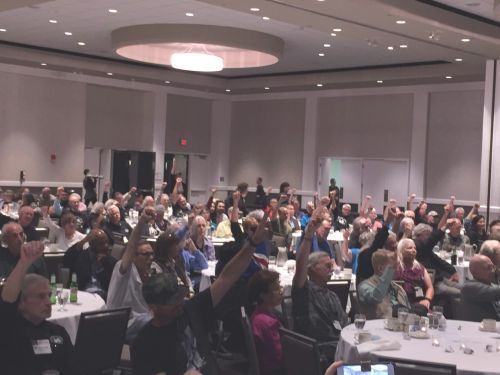
August 27, 2018 Ryukyu Shimpo
Special Correspondent Yukiyo Zaha reports from Minnesota
On August 25, the peace organization Veterans for Peace (VFP), comprised of former military personnel and supporters, held a plenary session of its 33rd annual convention in Saint Paul, Minnesota.
VFP unanimously passed a resolution asking that the Government Accountability Office (GAO) independently investigate the plan to build a replacement facility for Futenma Air Station in Henoko, Nago City.
The Veterans for Peace Ryukyu/Okinawa Chapter Kokusai (VFP-ROCK), which is coordinated by Douglas Lummis, raised this resolution.
This resolution points out that there are alterations that should be made to the facilities as set out in the GAO’s 2017 Marine Corps Asian-Pacific Realignment (GAO-17-415), including that the proposed runways are of insufficient length.
It states among other items, that (1) there is soft ground in the ocean which has not been determined sufficiently firm to support the runways, (2) there are buildings in the surrounding area that exceed US military height limits, and (3) there are active faults below the site.
In addition, the resolution claims that the Japanese government has not proved a reliable informant regarding the replacement facility project.
With the resolution the VFP requested that the GAO conduct indepentent investigations, and asked that it determine the risks associated with forcing through construction of the replacement facility.
VFP Board President Gerry Condon said in an interview that this resolution is very strategic.
He mentioned that the GAO has already submitted its report on the Henoko construction plans, and that VFP wants the GAO to investigate the plans from a different angle.
Condon said that over the next week or two he wants to make contact with the GAO and put on the pressure.
The VFP was founded in the US and has branches in the UK, Vietnam, South Korea, and more, with membership of about 3,000 people.
This is the third time in three years that the VFP made a resolution concerning the plan for the Futenma replacement facility in Henoko, Nago.
A Unified Wish for Peace
Special Correspondent Yukiyo Zaha reports from Minnesota
On August 25 in Saint Paul, Minnesota, at an evening session of the VFP’s 33rd annual convention, VFP-ROCK members Alice Newberry from Washington, DC, and Shisei Touma from Yomitan Village spoke in front of about 300 people. They called attention to the necessity for solidarity not only with the sense of impending danger as soil depositing work in Henoko draws closer, but also in the fight for Okinawa, in the fight against US militarism worldwide, and in the fight against racial discrimination. Applause resounded throughout the meeting hall at these words.
Newberry’s mother Ritsuko was from Miyakojima City.
During her speech, Newberry mentioned the third day of Obon, which was taking place in Okinawa.
She said: “Obon is when our ancestors come back to visit us, and on the third day we send them home. With three days we celebrate our ancestors, and tonight as we send them back home I want to send them back with a promise. I want to promise them that there are freedom fighters and veterans right here in this room that will work to fight for the freedom of Okinawa, and for the children of Okinawa.”
Newberry continued, “My ancestors are survivors of war, and it was forced upon them.Today, many Okinawans suffer generational and historical trauma from US militarism. They cannot escape the memory of war, because it is living and with them today.”
In addition, she called for solidarity among diverse people as the root of the fights for peace are all connected; the Okinawa base opposition movement, the fight against racial discrimination and police brutality in the US, the existence of more than 800 US bases throughout the world, and many others.
Touma has been with VFP for three consecutive years. In his speech he expressed gratitude for the adoption of the resolution against the Henoko replacement facility plan, and said, “However, the Japanese government is still forcibly pushing through new base construction for the US. Their plan is to fill up our pristine ocean of Henoko.”
He said that this resolution requesting that the GAO conduct investigations “has the power to speak to the US government, which will then turn into pressure on the Japanese government.”
Hopefully, he continued, “I’m sure your voices opposing the proposed base in Henoko will give Ryukyu Okinawan people renewed hope and courage.”
Those gathered also took the time to remember those VFP members who passed away over the previous year, and expressed their messages of condolence at the passing of Okinawa Governor Takeshi Onaga as well.
(English translation by T&CT and Erin Jones)
Go to Japanese
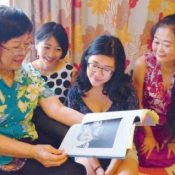
August 22, 2018 Ryukyu Shimpo
“The young woman in the picture is me.” Some American university students were searching for a woman in a photograph published on the front page of the local news in Ryukyu Shimpo on August 15, which was from U.S. military-occupied Okinawa in 1952.
They succeeded in finding her, and interviewed her on August 21.
The woman from the photograph is 74-year-old Masako Arakaki who lives in Kadena Town.
When these students visited Arakaki’s home they could hardly contain their excitement.
They said they had always wondered what kind of stories the people in these photographs had to tell, and that they were very happy to actually meet one at last.
When the photograph was taken in 1952, Arakaki was 8 years old and lived in Nodake, Ginowan City.
When she came home from elementary school, she used to search for playmates and frequently walked around the neighborhood.
In the photograph, the young girl who appears to be Arakaki is carrying a younger child on her back.
Arakaki said, “There were neighborhood people who often entrusted me with babysitting, I think the child in the photograph was one of those [I babysat].”
The young girl in the photograph had a stern expression with eyebrows knit, showing a strong-willed appearance while glaring at the camera.
In reaction to the photograph, Arakaki said, “At the time I was mischievious, and I always had that expression.”
She produced a photograph of herself from when she was a fourth year elementary school pupil, confirming, “I have the same mole near my mouth, no mistake, I think this is me.”
The photograph is one in a collection taken between 1952 or ’53 by a U.S. military surgeon, Charles Eugene Gail, stationed at Torii Station in Yomitan Village.
Gail took pictures throughout Okinawa, and 150 of these photographs remain.
In 2013 the University of California, Santa Cruz, started following the footsteps of people in photographs from the U.S. occupation, calling it the “Gail Project.”
Arakaki is the first person the project has found in the 5th year since it was started.
A junior year student at the university, 21-year-old Julia Jen, said this is the first time they found someone through a newspaper and she truly feels the power of the media.
She voiced her ambition to also absorb more radio and television, and find many more people.
These university students will return to the U.S. on August 30 and continue looking for people from the photographs.
More photographs can be viewed on the Gail Project homepage.
For more information, email President Alan Christy of Cowell College at UC Santa Cruz.
Her email address is achristy@ucsc.edu.
(English translation by T&CT and Erin Jones)
Go to Japanese
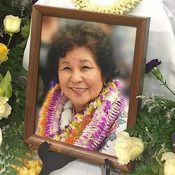
August 20, 2018 Ryukyu Shimpo
By correspondent Hanae Gushiken Higa
On August 9, a funeral and memorial service for Jane Serikaku was held at the Hawaii Okinawa Center on Oahu.
Serikaku served as the first female chair of the Hawaii Okinawa United Association (HUOA) and served as a managing director, acting as a bridge between Okinawa and Hawaii for more than 30 years.
Serikaku died on July 6 at the age of 79. Approximately 800 people attended the ceremony to commemorate her.
The venue was filled with flowers.
At the ceremony hosted by HUOA, Hawaii Governor David Ige, Honolulu City Mayor Kirk Caldwell, and Consul-General Koichi Ito read condolence messages.
These messages said things like: “Ms. Jane was a person who always cared about people around her, and respected each person like her family,” and “I learned a lot from her.”
One-by-one, people shared their thoughts about her.
Serikaku’s older sister Nancy and her three nieces performed hula. Afuso-ryu Gensei Choichi-kai Hawaii performed Serikaku’s favorite songs Jyuku no haru and Tinsagunu hana.
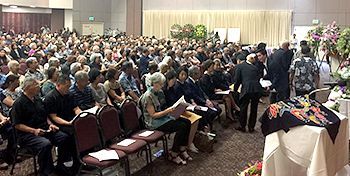
People attending the memorial service on August 9 in Hawaii
Serikaku is second-generation Okinawan from Maui who has roots in Nakagusuku village.
She served as a chair of HUOA from 1993 to 1994. As a managing director since 2006 she has been responsible for accepting and coordinating prefectural and municipal delegations visiting Hawaii.
She took a role as a coordinator between Hawaii and Okinawa and contributed to the development of human resources and the advancement of cultural exchange.
She emphasized on a daily basis that, “The future of HUOA depends on young people.”
Also, for more than 28 years she has coordinated high school student exchange programs between Hawaii and Okinawa. She even developed a project to send young Okinawans in Hawaii to Okinawa to learn the culture and history of their homeland.
Serikaku served as principal at Iliahi Elementary School for many years and received the Milken Educator Award in 1998.
Her daughter Michelle and her relatives said, “We are very proud of her achievement up to this point. We are thankful that the Okinawan community has supported her like family.”
(English translation by T&CT and Megumi Chibana)
Go to Japanese
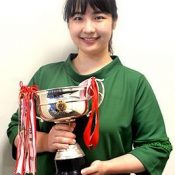
August 24, 2018 Ryukyu Shimpo
The 50th Japanese National Student Association (JNSA) All-Japan English Speech Contest was recently won by Okinawan-born Marino Uezu, a second year student at Ochanomizu University.
Uezu took the top spot this year after coming close the previous year in the same contest.
“I feel joy and a sense of accomplishment,” said, Uezu, smiling.
The competition features 53 college students enrolled in the JNSA, and the top 10 speeches are chosen as champions.
Uezu’s speech took on a theme based on a speech given by Apple founder Steve Jobs where he said, “Regardless of the variety of experiences you have, they take some sort of shape in the future. Threads and points link together.”
The speech spoke of her roots, which include an American grandfather, as well as Okinawan history.
“I love Okinawa, so much that I was hesitant to go to college outside the prefecture. I thought from the start that I wanted to do a speech based on Okinawa, and I was glad I was able to make it happen.”
In May, Uezu took part in a global speech contest for people 16-20 years old.
“I want to keep expanding my view of the world and trying new challenges. I plan on studying abroad next year.”
(English translation by T&CT and Sam Grieb)
Go to Japanese
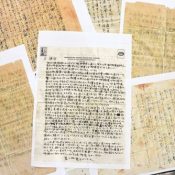
August 24, 2018 Ryukyu Shimpo
By Chie Tome and Tomoki Yasutomi
On August 23, 15 letters addressed to Okinawans and Okinawan descendants living in Hawaii sent from a prisoner of war (POW) camp between 1945 and 1946 were discovered.
The letters were written by people originally from Okinawa, who became POWs of the U.S. military during the Battle of Okinawa.
They were relocated and forced to live as POWs in Hawaii. The letters detailed various sentiments and scenes, such as: the gratitude felt toward emotional and material support experienced while in Hawaii, the determination stirred up by the idea of reconstructing one’s homeland after returning, and struggling with the post-war aftereffects.
An expert in literature regarding the Battle of Okinawa and former University of the Ryukyus Professor Masanori Nakahodo said, “This is the first time that I’ve seen letters that were written from the inside of the POW camp. These are a valuable resource for understanding the time period.”
The letters were kept by Masao Kinjyo, who lives in Hawaii and is the father-in-law of Jimmy’s company President Seiichiro Inamine.
The letters were then donated to the University of Hawaii.
According to President Inamine, Kinjyo has been a teacher at a Japanese language school for many years and since he is also an expert in dialects, pupils of Okinawan descent and/or their families entrusted him with the letters several decades ago.
“Kindness that is deeper than the ocean and higher than the mountains; how shall I repay that kindness?” read a letter that detailed the joy felt by a POW who was reunited with their older biological sister, who had left for Hawaii before the war.
The letter also writes how “A Painting of a Keepsake” that was drawn while the POW was in the camp was sent as a token of appreciation for a hospitable reception.
Another letter wrote about gratitude. The letter was addressed to an Okinawan who frequently delivered things to POWs who worked near the person’s home, even though meeting with POWs was forbidden. The letter wrote, “I cannot help but cry for your warm sympathy, despite being a complete stranger.”
Some letters wrote about how Okinawan descendants in Hawaii promptly delivered relief goods to Okinawa post-war as a part of relief work for victims. The same people also prayed for the quick recovery of their homeland.
Regardless of the content of the letters, the POWs were very likely to have given the letters directly to Okinawans and Okinawan descendants in Hawaii or delivered them through family members and acquaintances.
(English translation by T&CT and Chelsea Ashimine)
Go to Japanese
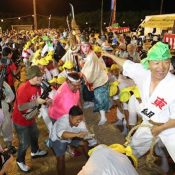
August 20, 2018 Ryukyu Shimpo
On August 19 the traditional Great Tug-of-War of Henoko was held at the Henoko Ground.
The community split into East and West teams for tug-of-war, and the West team won with one victory and one draw.
This event, where Henoko Ward reseidents come together to compete, takes place once every three years.
Starting at 5:00 p.m. the two sides paraded their team captains, and local children carried portable shrines, chanting “Wasshoi, wasshoi.”During a Henoko youth group’s Eisa performance, loud drum sounds cut through the area, and the youth danced with energy and vigor.
There was also a powerful demonstration of Bojutsu (martial arts with a stick) on the stage.
Young people carrying torches made a circle and bustled about the place chanting, “Tei, bii, gaa, ehh.” Ward residents and American soldiers rushed into the circle waving things like handkerchiefs at the falling sparks and yelling, “Saa, saa, saa.”
Amongst the reverberating sounds of conch shells, drums, gongs, and more, the male and female sides of the rope were attached by inserting the kanuchi stick.
With a signal from the stage, the tug-of-war commenced.
The first match resulted in an overwhelming victory for the West.
In the second match the rope was pulled both to the West and the East, but resulted in a draw.
Ward leader and head of the tug-of-war action committee Munekatsu Kayo said: “We will take seriously handing down to future generations the traditional culture that has been handed down to us.
Let’s deepen the bonds between us as ward residents.”
(English translation by T&CT and Erin Jones)
Go to Japanese
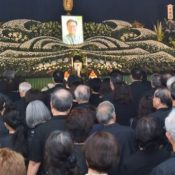
August 14, 2018 Ryukyu Shimpo
A memorial service for Okinawa governor Takeishi Onaga, who passed away at age 67 on August 8, was held at Daitenji temple in Naha August 13.
This is the first time that an Okinawan governor has died while still in office.
Approximately 4,500 attended the ceremony to say farewell to Governor Onaga, who fulfilled his duties as the leader of Okinawa’s government right up until the end.
Observers came to pay their respects and give gratitude to the man who spent his live pursuing the belief that the unreasonable nature of the base issue in Okinawa should be made known nation-wide.
Okinawa Prefecture organized an executive committee from members of the Okinawa Prefectural Assembly and other related organizations who will continue to make preparations for a public memorial.
At noon on August 13, a car carrying Governor Onaga’s remains and portrait departed from his home and traveled past Naha City Hall and Okinawa Prefectural Office, where Onaga held office during his life, before making its way to the funeral at Daitenji.
Employees from both Naha City Hall and the Prefectural Office as well as many Okinawan residents followed the procession carrying banners with messages such as “Thank you Governor Onaga.”
At the funeral held right before the memorial service, former governor Keiichi Inamine said in his remarks, “The heart of Okinawa that longs for peace will be passed on to the next generation.”
At the general incense offering, representatives from political offices, businesses, and organizations were followed by countless other residents to say their farewells.
Governor Onaga had one of the highest approval ratings amongst all of Okinawa’s governors for standing up to both the Japanese and American governments’ efforts to relocate MCAS Futenma to Henoko in Nago City, and for calling for a reduction to Okinawa’s excessive base-hosting burden.
His sudden passing was met with surprise and sadness, with condolences and flowers coming in from not just Okinawa but all over the country.
Governor Takeshi Onaga died at 6:43 p.m. on August 8 after being hospitalized due to complications from pancreatic cancer.
(English translation by T&CT and Sam Grieb)
Go to Japanese
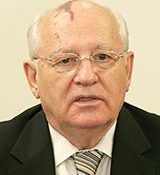
August 11, 2018 Ryukyu Shimpo
On August 10, Former Soviet Union leader Mikhail Gorbachev, who was a leading figure in Cold War and received the Nobel Peace Prize, dedicated a eulogy to the late Governor Takeshi Onaga.
In the eulogy, Gorbachev says, “The base principle of his activities was a battle for peace. Opposition to the expansion of the military base and improvement of the living environment were the two wheels (of his activities).” He concluded, “Takeshi Onaga will live forever within us.”
Gorbachev said to Toshinobu Hattori, a representative of the Japanese office of the Gorbachev Foundation, that, “Onaga is not only a representative of Okinawa, but also superior among Japanese politicians. He is the kind of person who would have been a capable future prime minister.”
The eulogy was written on August 9 to Mrs. Mikiko Onaga, the wife of Governor Onaga. On the 10th, Hattori sent the letter to Shintaro Kuniyoshi, president of the supporters’ association for Governor Onaga.
The eulogy sent from Gorbachev
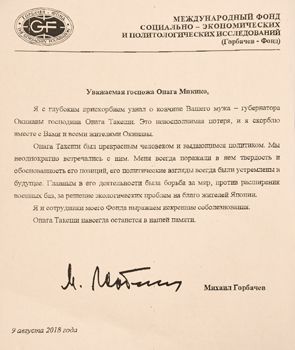
The eulogy that Mikhail Gorbachev dedicated to the late Governor Onaga
Dear Mrs. Mikiko Onaga
I express my deepest condolences for the sudden loss of Governor Takeshi Onaga. I was looking forward to seeing him again. Words cannot express how saddened I am.
Takeshi Onaga was an excellent politician and a respectable human being. I have met him many times.
He always had a definite vision for the future while maintaining a constant and solid will. The base principle of his activities was a battle for peace. Opposition to the expansion of the military base and improvement of the living environment were the two wheels (of his activities).
I and all the staff of the Gorbachev Foundation would like to express our heartfelt condolences and I would like to share this sadness with the people of Okinawa Prefecture.
Takeshi Onaga will live forever within us.
August 9, 2018
In Moscow
Mikhail Gorbachev
* translated from the Japanese translation of the letter
(English translation by T&CT and Megumi Chibana)
Go to Japanese
August 21, 2018 Ryukyu Shimpo
The Japanese government announced August 20 that if construction were to be suspended due to Okinawa Prefecture’s revocation of approval for land reclamation activity, which is part of the plan to relocate MCAS Futenma to the Henoko neighborhood in Nago, Okinawa, they calculate that they would incur a loss of approximately million yen per day.
As a result, currently the government is considering seeking damages in the event that they win the current lawsuit suit regarding said revocation.
If Okinawa Prefecture is able to officially revoke the approval for land reclamation activity, the Japanese government loses the legal foundation for the Henoko relocation and construction would stop.
As a preventative measure, the Japanese government has petitioned the court for a stay to freeze the revocation from taking effect, and if the request is granted they are expected to request the freeze continue until construction can start in earnest.
The Japanese government’s calculation of a 20 million per day loss comes from things such as delays in personnel and material acquisition costs, and has the potential to reach as high as hundreds of millions of yen.
However, a government official said that the decision of whether or not to seek damages, “may change based on the result of Okinawa’s gubernatorial election,” and will base their decision on the situation at that time.
Construction was also suspended when the late Governor Onaga initially revoked the land reclamation approval in October of 2015.
The Supreme Court in Japan ruled this to be illegal in December of 2016, however the Japanese government did not seek damages at that time.
When asked about the possible seeking of damages at a press conference August 20, Vice Governor Kiichiro Jahana commented, “We are resolutely prepared.”
(English translation by T&CT and Sam Grieb)
Go to Japanese
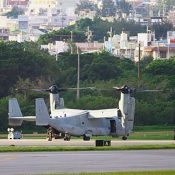
August 15, 2018 Ryukyu Shimpo
On August 14, there were successive emergency landings of MV-22 Osprey vertical takeoff and landing aircraft from MCAS Futenma Air Station at Amami Airport in Kagoshima Prefecture and at Kadena Air Base.
The causes of these emergency landings are unknown, and there is no information on injured persons.
According to eyewitnesses, emergency vehicles rushed up to the Osprey that landed at Kadena, and it was clear there was some sort of trouble that led to the landing.
However, according to information released by the Okinawa Defense Bureau and other organs, the Osprey that landed at Amami Airport did so due to observance of protocol when a warning light illuminated in the cockpit.
At Kadena Air Base, one MV-22 Osprey aircraft came in at 5:50 p.m., and at 6:30 p.m. another landed.
One of these landings was standard.
Both Osprey took off at about 7:00 p.m. from Kadena and returned to Futenma Air Station.
The ODB told the Ryukyu Shimpo, “We are still confirming all the facts.” An Okinawa Prefectural Government representative said, “We are continuing to collect information.”
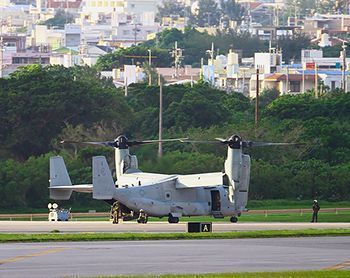
An MV-22 Osprey making an emergency landing at Kadena Air Base on August 14 around 6:30 p.m. (Photograph courtesy of a Ryukyu Shimpo reader)
At 5:22 p.m. another MV-22 Osprey made an emergency landing at Amami Airport. According to the Kyushu Defense Bureau, one crewmember remained on the MV-22, and at 7:19 p.m. the aircraft departed.
About 40 minutes later, another aircraft came to retrieve the remaining crewmembers.
The exterior of the aircraft did not appear damaged.
Civilian flights at Amami Airport were delayed by 25 minutes at most.
The ODB stated that information from the U.S. military indicated that due to a warning light illuminating in the cockpit, the protocol was for the aircraft to land at Amami Airport, and that it took off as soon as its safety had been confirmed.
The ODB requested that the U.S. military provide thorough information on its safety controls.
Multiple U.S. military Osprey have made emergency landings at Amami Airport in the past couple of years.
In June this year it was an Air Force CV-22 Osprey, and there were MV-22 Osprey in June last year and April this year.
In February, an MV-22 Osprey from Futenma Air Station had a window piece fall onto school grounds on Ikeijima in Uruma City, Okinawa.
(English translation by T&CT and Erin Jones)
Go to Japanese
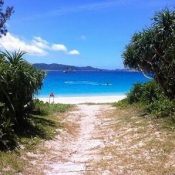
August 16, 2018 Ryukyu Shimpo
On August 15, TripAdvisor, the world’s largest travel review site announced Japan’s top 10 best beaches.
Furuzamami Beach in Zamami Island, Okinawa Prefecture that came in third last year won first place this year.
Yonaha Maehama Beach in Miyakojima came in second, same as last year.
In third place was Nishihama Beach in Hateruma Island, which was first place last year.
While there were changes in the ranking, the beaches in the top three did not change.
The top five were all Okinawan beaches. Seven beaches from Okinawa were nominated for the top ten and three of which made it to the top 10 for the first time.
The top 10 beaches that were announced were based on tallying up numbers from traveler ratings and number of reviews from people around the world that were posted in the year between November 2016 and October 2017.
Furuzamami Beach, which moved up two ranks since last year’s announcement, has a distinctive blue ocean that is called “Kerama Blue” by diving visitors. Many tropical fish also inhabit the many coral reefs that grow in the area, which many divers and snorkelers enjoy.
Reviewers commented on how surprised they were to see such a variety of coral and fish, making it an ideal location for snorkeling.
Some commented on how the ocean is much more beautiful than the resort beaches in Phuket, Bali, and Vietnam.
Others mentioned how impeccable the beach is and that it is like the Dragon Palace from the Japanese fairy tale Urashima Taro.
Sunayama Beach on Miyakojima came in fourth place.
The Okinawan beaches that came in fifth or below were all newcomers. Aka Beach in Zamami
(English translation by T&CT and Chelsea Ashimine)
Go to Japanese













 Webcam(Kokusai Street)
Webcam(Kokusai Street)


